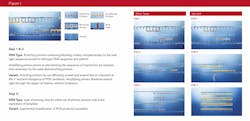PCR-based DNA enrichment enhances detection of mutations in oncology
The polymerase chain reaction (PCR) in its many forms has become a routine clinical and academic laboratory assay during the past 20 years. Assays range from microbial detection in soil for oil exploration,1 to food analysis,2—to mutation analysis in cancer diagnostics.3 The basis of all PCR assays is the biochemical interaction between key components of the reaction (template, primers, nucleotide, and polymerase) during repeated cycles of denaturation, priming,j and extension (thermocycling) to rapidly and reliably copy DNA.
The sensitivity of PCR is excellent, even from minute DNA samples, and this sensitivity is achieved by the exponential amplification of as little as one copy of a DNA fragment. However, this sensitivity is not suited to all situations; for example, it is not suited to the detection of a few mutated DNA copies in a great excess of normal (wild type) DNA. In this instance, pre-selection of mutated DNA copies would be required, and this can now be achieved through PCR-based DNA enrichment. Notably, this new technique is opening up new possibilities in cancer diagnosis and treatment monitoring, particularly when combined with liquid biopsies.
PCR-based DNA enrichment
PCR-based DNA enrichment relies on a modification of PCR principles to enrich a mixed DNA template for rare sequences. Such rare sequences, or mutations, are typically associated with resistance or sensitivity to certain drug types in cancer treatment. Due to tumor heterogeneity, cancer biopsy samples typically contain a low abundance of mutated DNA in a high background of wild type DNA. Even with the exponential amplification of a PCR reaction, the mutated sequence is often present at such low levels that the wild type DNA prevails in the reaction and subsequent downstream sequence analysis.
Identification of rare single nucleotide polymorphisms (SNPs, i.e., mutations) in a DNA sequence that alter the function of the encoded protein is becoming increasingly important in cancer treatment pathways to monitor disease and treatment progression. Examples of these SNPs include BRAF V600E in melanoma, EGFR T790M and L858R in lung cancer, and various mutations in codons 12, 13, and 61 of KRAS found in colorectal cancer.4-10 In these instances, PCR-based DNA enrichment can provide a valuable tool to increase the detection of a mutated sequence in a cancer biopsy, be it a solid tumor sample or a blood/plasma sample.
PCR-based enrichment methodology
PCR-based DNA enrichment uses modifications to the principles of PCR such that wild type DNA amplification is suppressed and mutant/SNP DNA is exponentially amplified. The method requires the design of two primer sets, one pair specific for the wild type DNA at the potential site of the SNP (these are the enriching primers) and a second set upstream of the mutation site (these are the amplifying primers). See Figure 1.
The enriching primers contain a blocking moeity (typically a DNA analogue) that is incorporated into wild type PCR reactions, which prevents exponential amplification of wild type sequences and hinders the amplifying primers from extending through the blocked site. When an SNP is present in the DNA sample, the enriching primers have a 5’ mismatch and fail to anneal efficiently; this allows annealed amplifying primers to extend and displace the enriching primers and run on through the mutation site. Products of this reaction are available for further rounds of the PCR, and thus exponential amplification of the mutation of interest is permitted. The blocking of wild type amplification allows for development of very sensitive assays suitable for use in the emerging field of cancer liquid biopsy.
Cancer diagnostics and monitoring
It has become apparent that sensitive molecular biology techniques such as PCR-based DNA enrichment could open new possibilities in cancer diagnosis and treatment monitoring when combined with liquid biopsies. This is because groups of cells within the same tumor can be genetically different and, following metastasis, they can be more different still. Relying on a single tissue biopsy can, therefore, give an incomplete picture of a patient’s disease. Liquid biopsies, using patient body fluids such whole blood and plasma, could overcome this problem while also avoiding the costly and dangerous invasive surgery associated with obtaining a solid tumor biopsy.
Liquid biopsies are based on the biological phenomena that tumors shed both cells and tumor DNA into the circulation. Known as circulating tumor cells11 (CTCs) and circulating tumor DNA12 (ctDNA) respectively, they are found in whole blood and plasma. The obvious benefit of a liquid biopsy is that samples are easier to obtain, but they can also be taken on multiple occasions to routinely monitor the state of the tumor and follow any genomic changes that are occurring with minimum discomfort to the patient. This serial sampling enables analysis of tumor genomic changes in real time, allowing clinicians to ensure that the therapy they have selected, based on a particular molecular target, remains relevant.
Case studies
DNA enrichment techniques have recently been used in studies using CTCs and ctDNA as the target.
KRAS mutations are found in many cancers but most notably in 40 percent to 50 percent of colorectal cancer (CRC) cases. These KRAS mutations are predictive of a very poor response to some monoclonal antibody therapies.4,5 In a study using CTCs isolated from an in vivo cannula, it was shown that cells expressing mutated KRAS genes could be isolated from the circulation of lung cancer patients.13 Certain samples showed wild type in the primary tumor but KRAS mutations in the CTC sample, demonstrating the utility of liquid biopsy as an early detection for mutations.
The epidermal growth factor receptor (EGFR) is the drug target for small molecule tyrosine kinase inhibitors, which have proved efficacious in non-small cell lung cancer (NSCLC) patients whose tumors carry sensitizing mutations in the EGFR receptor.6-10 However, a proportion of patients relapse following initial clinical response, and in many cases, resistance is caused by an acquired secondary EGFR kinase domain mutation T790M.9 In two studies,14,15 retrospective blood samples from lung cancer patients were interrogated for the presence of the EGFR T790M mutation. These studies isolated ctDNA from blood samples from lung cancer patients using small volume DNA extraction, followed by PCR-based DNA enrichment and traditional downstream Sanger sequencing analysis. The results determined that the presence of EGFR T790M mutation in the blood samples correlated with lower overall survival rates.14
Liquid biopsies as a diagnostic
Studies such as this demonstrate that analyzing tumor DNA from liquid biopsies (whether isolated CTCs or ctDNA) using PCR-based DNA enrichment can reveal not only a patient’s current cancer status, but also provide the opportunity for ongoing monitoring. This is vital for a diagnostic, particularly in the field of oncology, where the availability of the tumor biopsy may be limited and a liquid biopsy is the preferred option. The ability of DNA enrichment to facilitate mutant DNA analysis from a blood-based sample without the need for further biopsy has thus been established to be working at the levels required for it to be a usable system to follow the course of a patient’s treatment, once the appropriate regimen has been determined.
References
- Rasheed MA, Patil DJ, Dayal AM. “Microbial Techniques for Hydrocarbon Exploration” in Hydrocarbon, eds Vladimir Kutcherov and Anton Kolesnikov. 195-210.
- Kuchta T, Knutsson R, Fiore A et al. A decade with nucleic acid-based microbiological methods in safety control of foods. Lett Appl Microbiol. 2014;59(3):263-271.
- Heuckmann JM, Thomas RK. A new generation of cancer genome diagnostics for routine clinical use: overcoming the roadblocks to personalized cancer medicine. Ann Oncol. 2015;26(9):1830-1837.
- Amado RG, Wolf M, Peeters M, et al. Wild-Type KRAS is required for panitumumab efficacy in patients with metastatic colorectal cancer. J Clin Oncol. 2008;26(10):1626-1634.
- Freeman DJ, Todd J, Reiner M et al. Association of K-ras mutational status and clinical outcomes in patients with metastatic colorectal cancer receiving panitumumab alone. Clin Colorectal Cancer 2008;7(3):184-190.
- Maheswaran S, Sequist LV, Nagrath S, et al. Detection of mutations in EGFR in circulating lung-cancer cells. NEJM. 2008;359(4):366-377.
- Mack P, Holland W, Burich R, et al. Predictive value of EGFR and KRAS mutations detected in plasma from non-small cell lung cancer (NSCLC) patients treated with docetaxel and intermittent erlontinib. J Clin Onc. 2008; 26(15S):8062.
- Mack PC, Holland WS, Burich RA, et al. (2009). EGFR mutations detected in plasma are associated with patient outcomes in erlotinib plus docetaxel-treated non-small cell lung cancer. J Thorac Oncol. 2009;4(12):1466-1472.
- Kimura H, Suminoe M, Kasahara K, et al. (2007). Evaluation of epidermal growth factor receptor mutation status in serum DNA as a predictor of response to gefitinib (IRESSA). Br Jk Cancer.2007;17;97(6):778-784.
- Godin-Heymann N, Ulkus L, Brannigan BW, et al.“The T790M “gatekeeper” mutation in EGFR mediates resistance to low concentrations of an irreversible EGFR inhibitor. Mol. Cancer Ther. 2008;7:874-879.
- Isobe K, Hata Y, Kobayashi K, et al. Clinical significance of circulating tumor cells and free DNA in non-small cell lung cancer. Anticancer Res. 2012;32(8):3339-3344.
- Elshimali YI, Khaddour H, Sarkissyan M, Wu Y, Vadgama JV. The clinical utilization of circulating cell free DNA (CCFDNA) in blood of cancer patients. Int J Mol Sci. 2013;14(9):18925-18958.
- Luecke K, Hoon D, Kwasniak R, Gasiorowski L, Dyszkiewicz W. An effective in vivo liquid biopsy tool for high-yield isolation of circulating tumor cells. 2015; P2.04-086, WCLC 2015.
- Nishikawa S, Kimura H, Koba H, et al. Non-invasive analysis for T790M mutations of EGFR using a selective amplification method. AACR 106th Annual Meeting 2015; April 18-22, 2015; Philadelphia, PA. Cancer Res August 1; 75;2411.
- Kimura H, Nishikawa S, Koba H, Yoneda T, Sone T, Kasahara K. A rapid and sensitive method for detection of T790M mutations of EGFR in plasma DNA. CNAPS IX Berlin, September 2015.
Jo Pickford, PhD, serves as Research Scientist at EKF Molecular, which is part of parent company EKF Diagnostics.




